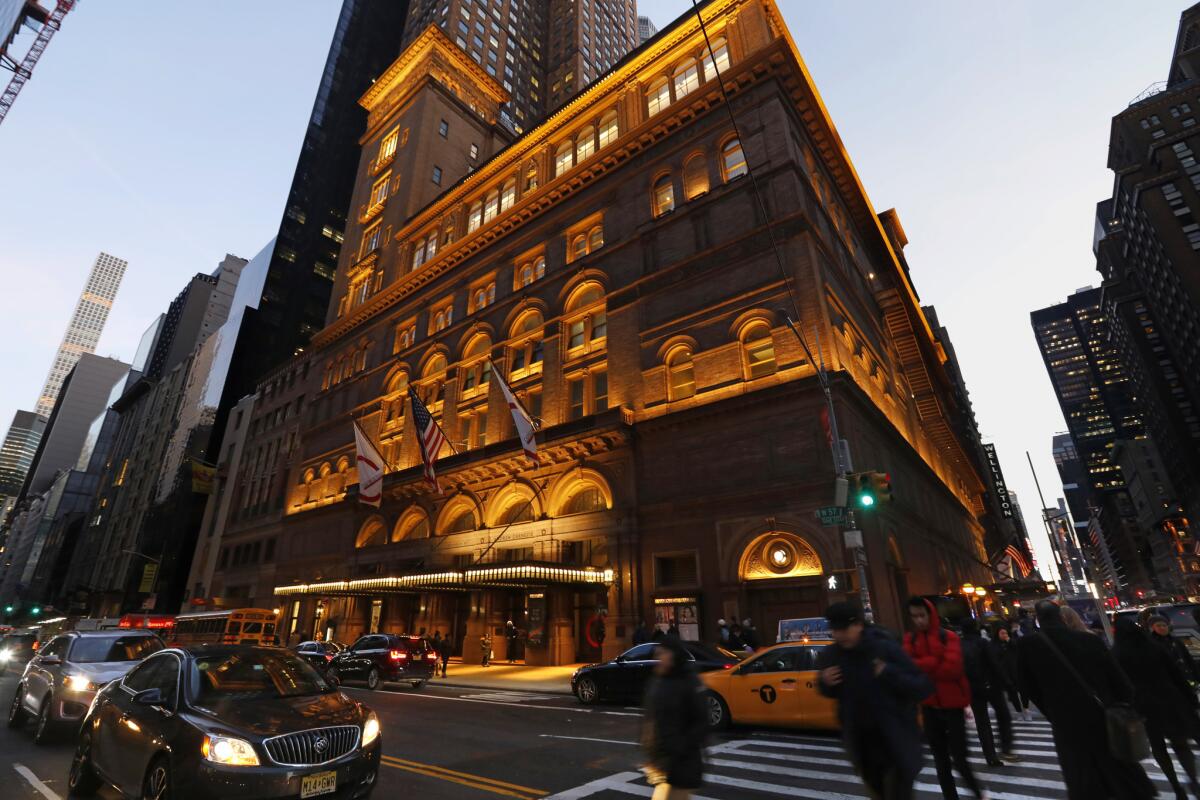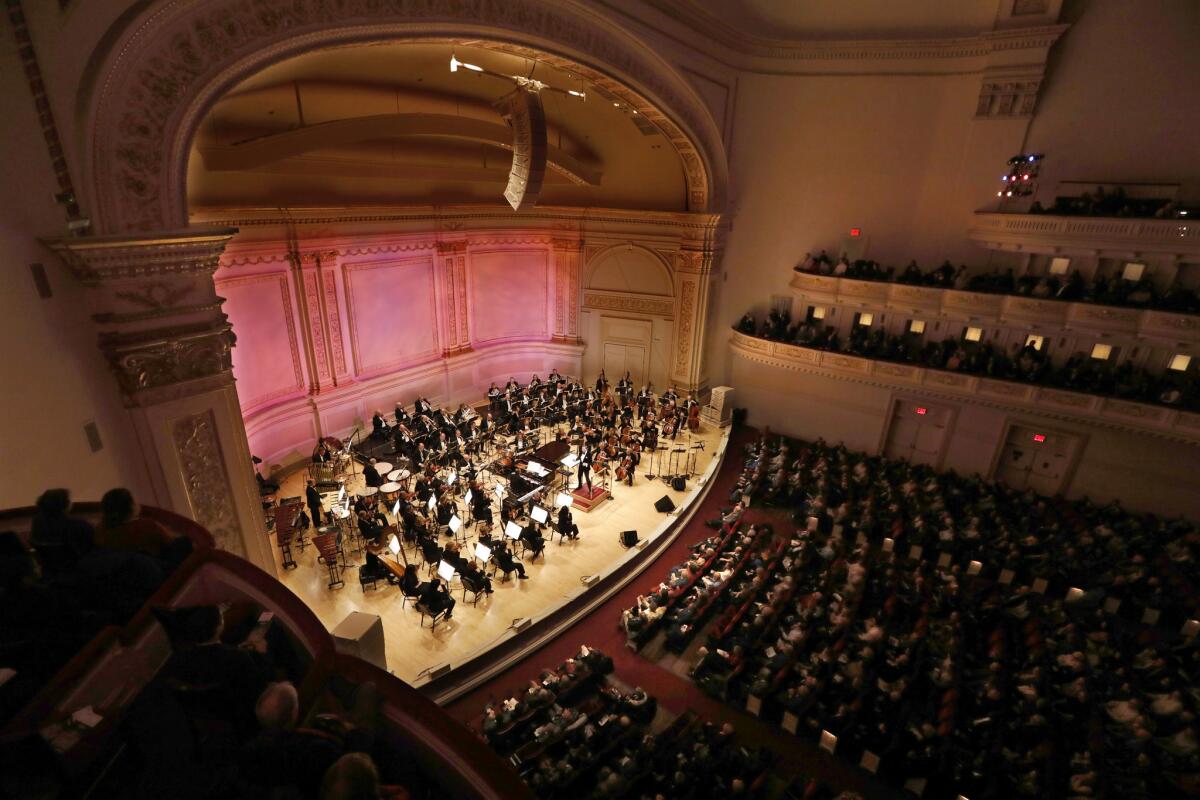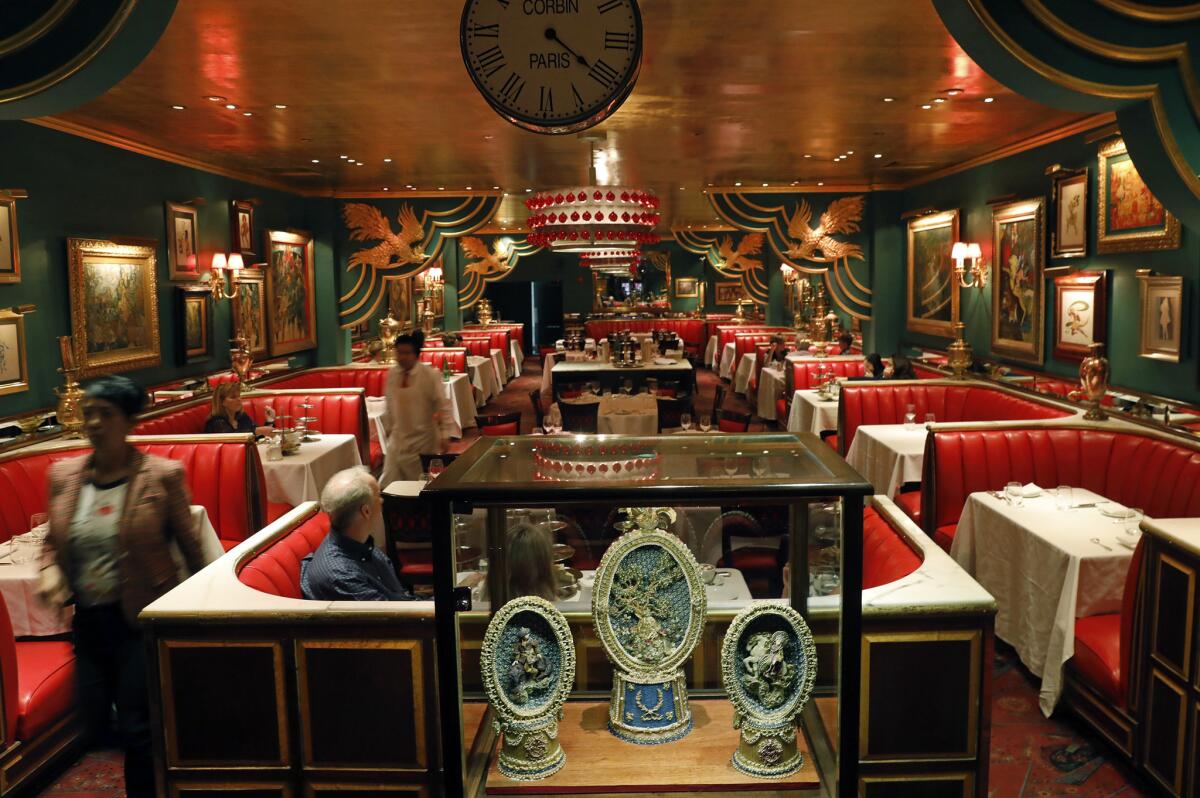Step inside New York’s Carnegie Hall, where beautiful music and stirring history ring out

- Share via
Sites and Sounds: This is the first in a series of occasional articles exploring great music venues of America.
Tine Thing Helseth, a 30-year-old Norwegian trumpeter, had just made her Carnegie Hall main stage debut with the Orpheus Chamber Orchestra. Now she stood center stage, applause resounding around her, a surprise up her sleeve.
Instead of raising her trumpet for an encore, she started singing, no microphone, no accompaniment. The song was the old standard “Smile.” Helseth’s delicate, disarming voice carried to every corner of the building.
“Smile, though your heart is aching….”
A charming, unexpected moment, but maybe I shouldn’t have been surprised.
Carnegie Hall has been in the business of these moments since 1891, when composer Tchaikovsky took to the stage to conduct his work on opening night.
Picture Antonin Dvorak unveiling his “New World Symphony” in 1893. Or the triumphant New York Philharmonic debut in 1943 of Leonard Bernstein as a last-minute fill-in conductor.
Gino Francesconi, the hall’s director of archives, estimates that 50,000 performances have taken place in the building, which includes two smaller venues besides the main hall. In fact, Francesconi said, “I think we’ve had more events here than any other theater on the planet.”
That’s a difficult assertion to nail down, but there’s no doubt that long history, great acoustics and big names have imbued this address with a singular mystique. When Benny Goodman wanted more respect for his big band in 1938, when the Weavers wanted the same for folk music in 1955, when Judy Garland staged her 1961 comeback, when the Beatles needed a venue for their first U.S. shows in 1964, all headed to Carnegie Hall. (You can hear music from many of those performances in my Carnegie Hall Spotify playlist above.)
And in 2009, when time came to assemble the first YouTube Symphony Orchestra after auditioning members from 30 countries, they gathered here.
A deep jewel box
If you were designing a daydream tour of America’s most historic and atmospheric music venues, you probably would start with Carnegie Hall.
And that’s exactly what I’m doing — because digital sound through earbuds is no substitute for being in the room where it happens. (Thank you, “Hamilton.”) I plan to visit several beloved music venues across the U.S. this year for a series of occasional articles called “Sites and Sounds.” (Suggestions? Send them to travel@latimes.com.)
I had never been to Carnegie Hall, so I flew to New York in early February and set about haunting the place.
My first move was to sign up for the standard public tour (offered October through June). The next thing I had to do, on my way in, was to admit that the building isn’t pretty.
Maybe it never was. It’s a big box of stodgy revival Italian Renaissance brick and brownstone, designed by an architect who had never done a concert hall and framed by 57th Street and 7th Avenue.
Inside, however, is another story. The main hall’s walls are white and almost Shaker plain, but then you spot scattered bursts of gold trim, as elegant as wedding-cake frosting.
The 2,804 seats are arrayed on five levels — a deep jewel box upholstered in deep red. And then, unseen but essential, are the room’s acoustics — perhaps the greatest achievement of architect William Tuthill, who played the cello in off-hours.
I don’t believe in ghosts and have little grasp of the physics of sound. But when our tour guide led us into the empty hall, up to the edge of that smallish stage (42 feet deep), I found myself straining to hear — as if the hall still carried the tiniest echo of every note that’s been played and sung there.
Then we moved on to the small but well-curated Rose Museum (open Sept. 17 through July 22; free). Here I inspected batons from Bernstein, Arturo Toscanini, Georg Solti and Herbert von Karajan; Goodman’s clarinet; and an autographed program from those first Beatles shows. (If you go, notice the goof on the bass player’s name: John McCartney.)
That night I caught my first Carnegie Hall performance, soul music by the New York Pops. The orchestra was joined by singers Capathia Jenkins (who played Medda in the Broadway production of “Newsies”) and James Monroe Iglehart (moonlighting from his gig as Lafayette/Jefferson in the Broadway production of “Hamilton”).
The house was nearly full, the dress code casual. Maybe the hall’s builders never imagined “Respect” or “Midnight Train to Georgia” in this space, but from my seat in the balcony, the show went down as easily as lemonade on a summer day. And I found myself thinking about real estate.
In the 1880s, when steel magnate Andrew Carnegie and company started laying plans for the hall, most Manhattanites lived at the southern end of the island. Their idea of midtown was 14th Street.
When Carnegie decided to build his hall on 57th Street near Central Park, he was gambling that he could lure audiences more than two miles out of their way.
That’s why selling out Carnegie Hall meant a lot in the old days — not because it stood on elite ground in the busy middle of the city but because it was in the suburbs.
Decades later the island had filled in and Carnegie’s hall had Times Square, Rockefeller Center and the Museum of Modern Art close at hand. The venue now possessed its elite reputation and an address at the center of Manhattan’s cultural action.
But the city was changing fast.
Stern steps up
In the late 1950s the New York Philharmonic, the hall’s biggest and most esteemed user, announced it would move to a new venue, Lincoln Center, to be built at 65th and Broadway.
Carnegie Hall would be razed. A developer’s sketch in the Rose Museum shows a bright red office building in the hall’s place.
Then violinist Isaac Stern stepped up. This was before historic preservation had become a popular cause, but Stern launched a campaign and won.
The city of New York bought the hall and designated the nonprofit Carnegie Hall Corp. to run it. (The venue’s main hall is officially known as Stern Auditorium.)
These days the corporation’s management team, eager to build and diversify audiences, presents about 170 concerts a year in the hall’s three venues. The 2018-19 season will include a series of concerts exploring the cultural effects of human migration, along with programs featuring conductor Michael Tilson Thomas, pianist Yuja Wang, composer-mandolinist Chris Thile and dozens of others in nearly every genre. (Tickets can cost anywhere from nothing to $290.)
And then there are the rental shows — about 500 in 2017-18.That’s how the Beatles got here, and it’s why so many student recitals and graduations fill the venue on spring weekends. (Want the main hall on a Saturday night? The base rate is $19,865.)
Still, the mystique endures. As pianist Leon Fleisher once told music writer Tim Page, the longest walk in the world is the one from these wings to the center of this stage.
“Playing for the first time somewhere is always special,” Copenhagen-based cellist Soo-Kyung Hong told me. “Playing the first time in Carnegie Hall — there is such an expectation to fulfill, and you think of the people who have played it before.”
Grab an apple and enter the Fillmore, San Francisco’s cradle of psychedelia that continues to rock »
When she first played the venue’s Weill Recital Hall in 2008 with her group Trio con Brio Copenhagen, Hong said, she thought most of Isaac Stern, “the guru of Carnegie Hall.”
But others will think of pianist Arthur Rubinstein, who gave his first Carnegie Hall performance in 1906, his last in 1976. Or Arturo Toscanini, who conducted more than 400 concerts in the hall.
An Angeleno might think of Esa-Pekka Salonen (who first appeared in 1988) or Gustavo Dudamel (2007).
Or you might think of Dizzy Gillespie and Charlie Parker (1947), Edith Piaf (1957), the Rolling Stones (1964), Buck Owens (1966), Led Zeppelin (1969) or Stevie Ray Vaughan (1984).
The hall’s performance history search page suggests that Elvis Presley never entered the building — but Elvis Costello has.
Playing the first time in Carnegie Hall — there is such an expectation to fulfill, and you think of the people who have played it before.
— Soo-Kyung Hong, cellist

My second Carnegie show was the Orpheus Chamber Orchestra with Helseth on trumpet. To my ears, the Bach and Albinoni sounded meticulous, and Mozart’s Symphony No. 40 galloped like a stallion.
The moment the music was done, I elbowed my way down the stairs and dashed out of the building.
Then I made a left turn on 7th Avenue and rushed back in again because I had another show to catch — a 9 p.m. program downstairs in Zankel Hall.
This 599-seat space beneath the main hall was a movie theater for decades, then reopened as a music venue in 2003. I hadn’t been seated for long when Rosanne Cash, curator of the venue’s “American Byways” series, stepped onstage to introduce singer-songwriter Ruthie Foster, a new name to me, followed by the North Mississippi Allstars.
I didn’t love the Allstars, but I did love Foster’s voice. And that made two happy musical surprises in a day. Or three, if you count the walk I took that afternoon in Central Park.
A few steps from the skaters at Wollman Rink, I heard the sound of a piano seeping from a pedestrian tunnel and found Nelson Grullon, recently arrived from the Dominican Republic, playing for tips, passionately and powerfully, on a portable keyboard.
He said he was looking for a hotel or cruise ship job and hoping to study at the Brooklyn Academy of Music. He had been too busy playing to visit any of the city’s landmarks. So no, he told me, he didn’t know the way to Carnegie Hall — at least, not yet.
The Russian Tea Room is next door, but that doesn’t mean you must eat there. Because of this restaurant’s long history as a Carnegie Hall-adjacent hangout (Leonard Bernstein wrote music here), I felt obliged to take a seat beneath the old samovars and gold ceiling.
I had been warned that it would be garish, expensive and full of tourists, but there was only one way to be sure. For the record, my beef stroganoff was tender and arrived quickly — but then for $42, it should have.
Barely 100 yards from the hall, you can get soup for $4, sketch a model for $7 and see where some of America’s greatest artists have honed their skills. The Art Students League of New York, whose building at 215 W. 57th St. is just a year younger than Carnegie Hall, has counted Thomas Hart Benton, Alexander Calder, Georgia O’Keeffe, Norman Rockwell, Jackson Pollock, Romare Bearden and Mark Rothko among its students and teachers.
Check out the league’s gallery of student work, then climb the stairs to the plain, cheap, tourist-free cafeteria. Order at the counter and nurse that soup.
Or show up a little before 5 p.m. any weekday, hand over $7 and join a studio sketching session with a live model.
You can’t ignore Lincoln Center. This enormous complex (30 indoor and outdoor venues clustered around Broadway and West 65th Street) arose in the 1960s as New York’s performing arts hub. Besides the New York Philharmonic and several other organizations, it’s home to the Metropolitan Opera, the New York City Ballet and the Juilliard School.
I paid $25.50 to catch a sprightly Sunday morning performance by Trio con Brio Copenhagen (piano, violin and cello) in the center’s 268-seat Reade Hall.

If you go
THE BEST WAY TO NEW YORK
From LAX, American, Delta, United and Virgin America offer nonstop service to New York, and American, Delta, United and Southwest offer connecting service (change of planes). Restricted round-trip airfares from $304, including taxes and fees.
WHERE TO SLEEP
Quin Hotel, 101 W. 57th St. at Sixth Avenue; (212) 245-7846. Sleek lodging with 208 rooms and an art and design emphasis. Doubles typically $315-$620 in spring and summer.
Blakely New York, 136 W. 55th St. between 6th and 7th avenues; (212) 245-1800. Doubles typically $269-$329 in spring and summer, as low as $149 in winter.
Hotel Wellington, 871 7th Ave. at 55th Street; (212) 247-3900. More than 500 rooms featuring strictly basics in a central location. Doubles as low as $250 in spring and summer, $125 in winter.
WHERE TO EAT
The Smith, 1900 Broadway at 63rd Street; (212) 496-5700. Zinc bar. Loud dining room with alert, genial service. Lunch and dinner main dishes $18-$46.
Brooklyn Diner, 212 W. 57th St.; (212) 977-1957. Egg creams, noodle kugel and pastrami on rye. Dinner main dishes $18-$26.
Black Tap Craft Burgers & Beer, 136 W. 55th St.; (212) 315-4356. Pop music, lively young servers, craft burgers and over-the-top shakes, several locations, lines out the door. Burgers $15-$20. Shakes $9-$17.
TO LEARN MORE
Carnegie Hall, 881 7th Ave. at 57th Street (main entrance on 57th); (212) 247-7800. Tours $17 per adult (plus $2.50 ticket fee). For concert schedule, check Carnegie website.
NYC&Co, for visitor information
christopher.reynolds@latimes.com
Follow Reynolds on Twitter: @MrCSReynolds
Sign up for The Wild
We’ll help you find the best places to hike, bike and run, as well as the perfect silent spots for meditation and yoga.
You may occasionally receive promotional content from the Los Angeles Times.




